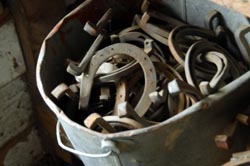Montana's Horse Industry
Updated: September 14, 2020

Another important industry in the state of Montana is the horse industry. In Montana there are nearly 130,000 registered horses. These include Quarter horses, Appaloosas, Arabians and Paints. There are also thousands of horses that are not registered with a breed association, so the number is actually much higher. Quarter horses are the favorite breed among people that work with cattle for their build and cow sense. Other breeds found in Montana include Morgans, Thoroughbreds, Tennessee Walkers, Miniature Horses, Norwegian Fjords, mustangs, New Forest Ponies, Warmbloods, Shetland Ponies, Andalusions, Paso Finos and draft breeds like Percherons, Clydesdales and Belgians.
Different breeds of horses are used for different purposes. For instance, draft breeds are used for pulling equipment or heavy loads. I'm sure you've learned about the homesteaders. Well, they used draft horses to pull their wagons across the prairie and to farm the land that they claimed. Quarter horses are used mostly for cattlework and roping. Thoroughbreds are prized for their showing, racing and jumping ability.

Today, the majority of horses are used for pleasure. For nearly 200 years farmers and ranchers relied entirely on the horse for work. Horses pulled plows, hay machinery, wagons and buggies. Some ranchers still rely on horse teams to pull hay wagons in the winter to feed the cattle. Even with the powerful machinery available today, in high snowfall areas horses are able to get the job done better. Horses are also used extensively on ranches to gather and move cattle from pasture to pasture.
Horses were first brought to this country by Spanish explorers. Soon Native Americans began using them to chase buffalo and move camps. When the settlers started arriving they used horses to pull covered wagons and as their only means of transportation.
Montana has many top quality breeding equines. Equine is the scientific name given to the horse. An equestrian is a person who rides a horse. A stallion is a male horse that has not been neutered, while a gelding is a horse that has. Geldings are the most widely ridden horses. Stallions and mares can be very temperamental and are usually not as reliable as geldings. A mare is pregnant for 340 days before she has a foal. A male foal is called a colt, while a female foal is called a filly. Many people mistakenly refer to all foals as colts whether they are male or female.

Domestic horses require much more care than other livestock. Wild horses, or mustangs are able to survive without human care. However, as man has tamed the horse, he must also take care of it. Horses eat grass, hay, grain and pellets. Horses that are kept inside all the time eat mostly hay and grain. Horses kept outside eat grass during the spring, summer and fall, and are fed hay in the winter. They also require a lot of water. On an average day of 70 degrees an adult horse will drink 11 gallons of water.
Horses are not able to digest food very well so they must have high quality feed. Horses have a cecum which is attached to the small intestine where the food must go through to be processed. Although they are able to eat roughage like cattle and sheep they do not have four stomachs to efficiently digest it. This is why horses eat all the time. They must eat only small amounts throughout the day in order to get the nutritional value from their feed.
Hooves and teeth are another important aspect of horse health. Most horses are shod every six weeks. That means they get a new set of shoes that often! Shoes are put on horses to protect their hooves from hard surfaces. Horeshoes are a U-shaped piece of metal that are nailed on to the hoof. The outside of the hoof is like our fingernails, so the horse cannot actually feel the nails. There are many different kinds of shoes for different uses. For example, racing shoes are lighter and toe and heel shoes are used for rocky areas to keep the hoof further off the ground.

Dental checkups are also in order for the horse. Horses grind their feed from side to side rather than in an up and down chewing motion. This wears the teeth down and creates sharp points on some of them. These points do not allow the horse to grind feed very well. To even them out they are floated. When a horses teeth are floated it means they are filed down with a large file called a "float."
Updated: September 14, 2020

